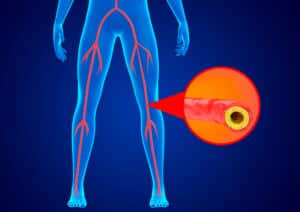
Risks of Developing PAD
You’re at risk of developing peripheral arterial disease:
- Smoking: Tobacco use is one of the most significant risk factors for PAD.
- Diabetes: People with diabetes have a higher risk of developing atherosclerosis and PAD.
- High blood pressure (hypertension): Uncontrolled hypertension can contribute to arterial damage.
- High cholesterol: Elevated levels of cholesterol can lead to plaque formation in the arteries.
- Obesity: Excess body weight can strain the circulatory system and contribute to arterial narrowing.
- Sedentary lifestyle: Lack of physical activity can increase the risk of PAD.
- Family history: A family history of PAD or atherosclerosis may increase one’s risk.
- Age: PAD becomes more prevalent with advancing age.
Symptoms of PAD
- Claudication is experienced as pain, cramping, or fatigue in the legs during physical activity, which improves with rest.
- Numbness or weakness in the legs or feet.
- Coldness in the lower extremities.
- Changes in skin color, such as paleness or blueness.
- Poor wound healing in the legs or feet.
- Erectile dysfunction in men (due to reduced blood flow to the genital area.
If left untreated, PAD can lead to more severe complications, such as non-healing wounds, infections, and in extreme cases, gangrene, which may necessitate amputation.
Diagnosis of PAD typically involves a physical examination, medical history review, and various diagnostic tests such as ankle-brachial index (ABI) or angiography. Treatment options may include lifestyle changes (such as quitting smoking, exercising, and dietary modifications), medications to manage risk factors like cholesterol and blood pressure, and in severe cases, endovascular procedures or surgery to open blocked arteries.
Request an Appointment
If you suspect you might have PAD or are experiencing any symptoms related to it, call the Vascular Institute of Virginia at 703-763-5224 to schedule an appointment. Early detection and intervention can significantly improve outcomes and reduce the risk of complications.

